Audio Delay
Delay Time versus Distance
| Meter |
Delay
in msec |
|
|
| 3.4 mm |
0.01 |
|
|
| 6.8 mm |
0.02 |
|
|
| 34 mm |
0.10 |
|
|
| 340 mm |
1.00 |
|
|
| Meter |
Delay
in msec |
Feet |
Delay
in msec |
| 3.40 |
10 |
20 |
17.9 |
| 5 |
14.6 |
30 |
26.8 |
| 10 |
29.2 |
40 |
35.7 |
| 15 |
43.8 |
50 |
44.6 |
| 20 |
58.5 |
60 |
53.6 |
| 25 |
73.1 |
70 |
62.5 |
| 30 |
87.7 |
80 |
71.4 |
| 34 |
100 |
90 |
80.4 |
| 35 |
102.3 |
100 |
89.3 |
| 40 |
117.0 |
110 |
98.2 |
| 45 |
131.6 |
120 |
107.1 |
| 50 |
146.2 |
130 |
116.1 |
| 55 |
160.8 |
140 |
125.0 |
| 60 |
175.4 |
150 |
133.9 |
| 65 |
190.1 |
160 |
142.9 |
| 70 |
204.7 |
170 |
151.8 |
| 75 |
219.3 |
180 |
160.7 |
| 80 |
233.9 |
190 |
169.6 |
| 85 |
248.5 |
200 |
178.6 |
| 90 |
263.2 |
|
|
| 95 |
277.8 |
|
|
Audible Echo
The audible echo or delay results in the time difference of the arrival of the sound from the source and the sound reflected on a reflective surface. Because the audible sound from the source is delayed already by the travelling distance from the source to the listener, the audible echo is created just by the travel distance between the listener and the surface and back to the listener! The closer one is standing to the reflecting surface the shorter is the audible echo. The audible echo is always longest at the source position.
An artist on stage is hearing the echo from the rear wall of a concert hall with the longest delay, in the audience this echo is getting shorter the further back one is sitting. The echo from the rear wall is inaudible directly at the rear wall.
Audible echo or delay time is always depending on the distance to the reflective surface and not depending on the distance to the sound source.
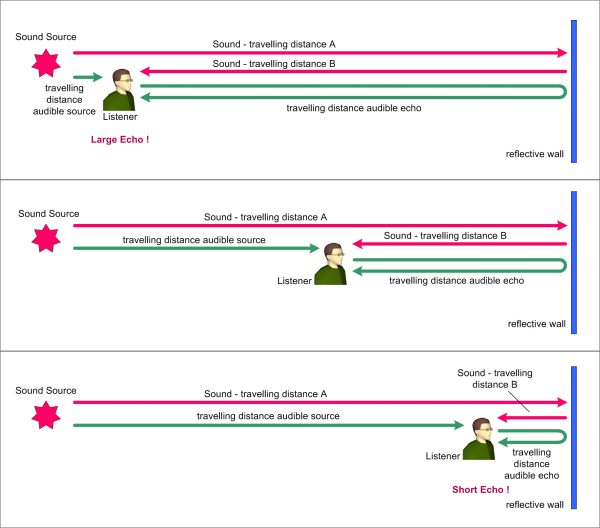 |
| different echo or delay times for different listening positions |
Delay Lines in Sound Reinforcement
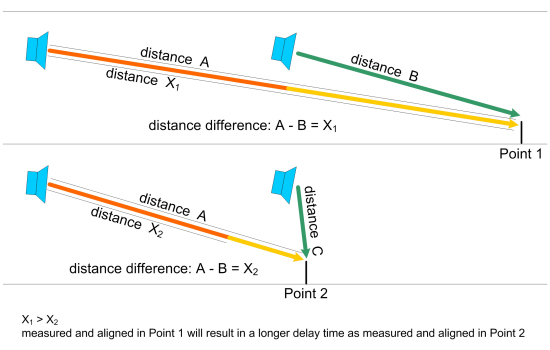 |
Delay lines should be aligned with the precise time difference of the sound arrival form the main speaker and the delayed speaker + a short additional delay for the precedence effect. The added short precedence effect delay of about 2 to 15 milliseconds will move the audible sound image back to the main speaker system.
A usual calculation for the delay time is: delay time to be set = distance difference X (meter) / 340 + 2 .. 5 msec
But because speakers must be installed at a certain height, no perfect alignment position can be found. If the measurement position is moved away further from the delay line speaker the fitting delay time will be longer, measured very closely to the delay line speaker the time will be shorter. Measured further away will bring automatically the desired precedence effect delay to the listeners closer to the delay line speakers. But conditions must be checked carefully at different positions.
But the examination above is valid only in a line straight underneath these speakers. Moving also to the side of the speakers in a real three-dimensional field makes things much more complicated.
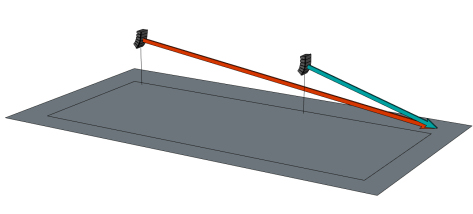 | |
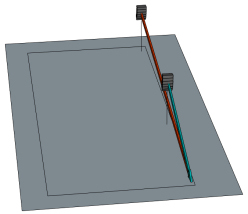 |
| listening point in line with loudspeakers |
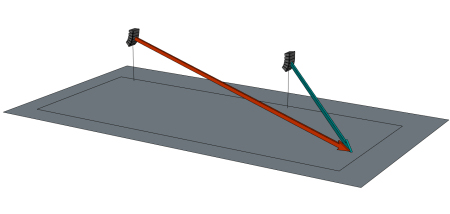 | |
 |
| listening point out of line with loudspeakers |
With a delay speaker system a large area must be covered. But each position on this area has a different resulting length difference "X" (see above) and a resulting different optimum delay time to be set for the delay speakers. No perfect measurement position can be found anymore: any position is and must be a compromise!







